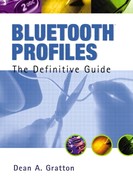This is a welcome book. Profiles have been one of the most ignored and least understood aspects of the whole Bluetooth specification. Within that is a very great concern, for profiles are what will ultimately make the Bluetooth specification either successful or one of the biggest failures within the wireless community. Unless everyone can be made aware of profiles and their effects—both developers and ultimately customers—then Bluetooth technology will not live up to its promise.
Behind that statement is Bluetooth’s biggest problem—its promise. The Bluetooth specification started life as a pretty modest idea: its goal was to replace cable—in particular, the cable between a mobile phone and a laptop PC. Along the way, that concept has struck a chord with developers throughout every sector of electronics design. From games to refrigerators, planes to cars, everyone can see a brave new world free of the apron strings of pieces of wire. But the very diversity of applications brings a dangerous sting in its tail. If a single standard can solve so many diverse problems, how can we ensure compatibility? As we contemplate the benefits that wireless applications can bring, new scenarios come to mind. Traditionally, a keyboard would only connect to a PC; yet once it is wirelessly enabled, why shouldn’t it connect to my phone to allow me to type text messages? Why shouldn’t my phone talk to my rental car to tell it my favourite seat position and radio preferences? They may sound implausible, but prototypes of both are already working. And many more new connection paradigms will be presented and tested as Bluetooth hardware becomes more freely available.
As time progresses and more devices gain the ability to talk to each other, the concept of the Bluetooth specification becomes a Babel of interoperability issues. No manufacturer will have the foresight to perceive every combination in which their product could participate. Left to a free market, the customer experience would quickly degrade as users discovered that some products worked with others, but that each individual product had a different compatibility matrix. To make the increasingly complex edifice workable, it became apparent that some form of guideline needed to be established to cover the essentials of each major application area, but that these also needed to ensure they did not cramp creativity. A way had to be found that provided flexibility yet ensured a base level of user experience. A similar problem had already been identified and solved within DECT, which introduced a Generic Access Profile to make handsets from different manufacturers compatible. Bluetooth developers have learned from that experience and introduced Bluetooth profiles.
That is what this book explores. As I read through the initial proofs, I was drawn back to the full specification. It has grown steadily over the past year and that growth emphasises just how important profiles have become. It reminded me of the old Monty Python sketch where John Cleese is being interviewed as a Shakespearean Actor. On being questioned about the leading parts, he categorises their relative importance by the number of words spoken. If the same gauge were taken to Bluetooth, it would tell an interesting story. The hardware and radio is fully defined in approximately one hundred pages. The stack takes a further thousand, but the profiles are already way past that and growing on a daily basis. Yet despite their superiority in page count, they are largely ignored. Within the Bluetooth community, the talk is of items like RF sensitivity or HCI transport, but rarely of profiles. Many misunderstand them and seem to write them off as a simple API without realising their true worth. Profiles are the key to Bluetooth interoperability. Any Bluetooth designer who does not fully understand them develops products with immense risk, because without them we are throwing away the foundation of user experience.
I hope that the pages that follow will help to bring the profiles to life and instill their real importance into the reader. They are not just a final hoop to be jumped through to gain an approval certificate, but the bedrock upon which “real” Bluetooth applications are built. If customers are to respect the Bluetooth brand, they will expect products to work out of the box. If they don’t, customers will shun the technology. First, customers will return products back to stores; then, customers will reject Bluetooth technology altogether. We have a duty to make it work and that means understanding and implementing profiles.
As with all books of this kind, what you will learn is only the beginning. I hope it will inspire you. As you read these pages, more working groups are developing additional profiles that further extend the bounds of Bluetooth’s potential. As a reader who I assume is already interested in developing Bluetooth applications, I’d recommend you review and participate in the profile creation process.
I share Dean’s enthusiasm—Bluetooth technology may never be the universal panacea that the marketing machine claims it to be, but properly implemented it can solve a remarkable number of problems and create a surprising number of new usage models. This is a valuable volume on that route. Each reader who leaves it with a better understanding of profiles will ultimately find that they are adding to the customer experience and by so doing helping the global success of the Bluetooth specification.
Nick HunnManaging DirectorTDK Systems Europe
